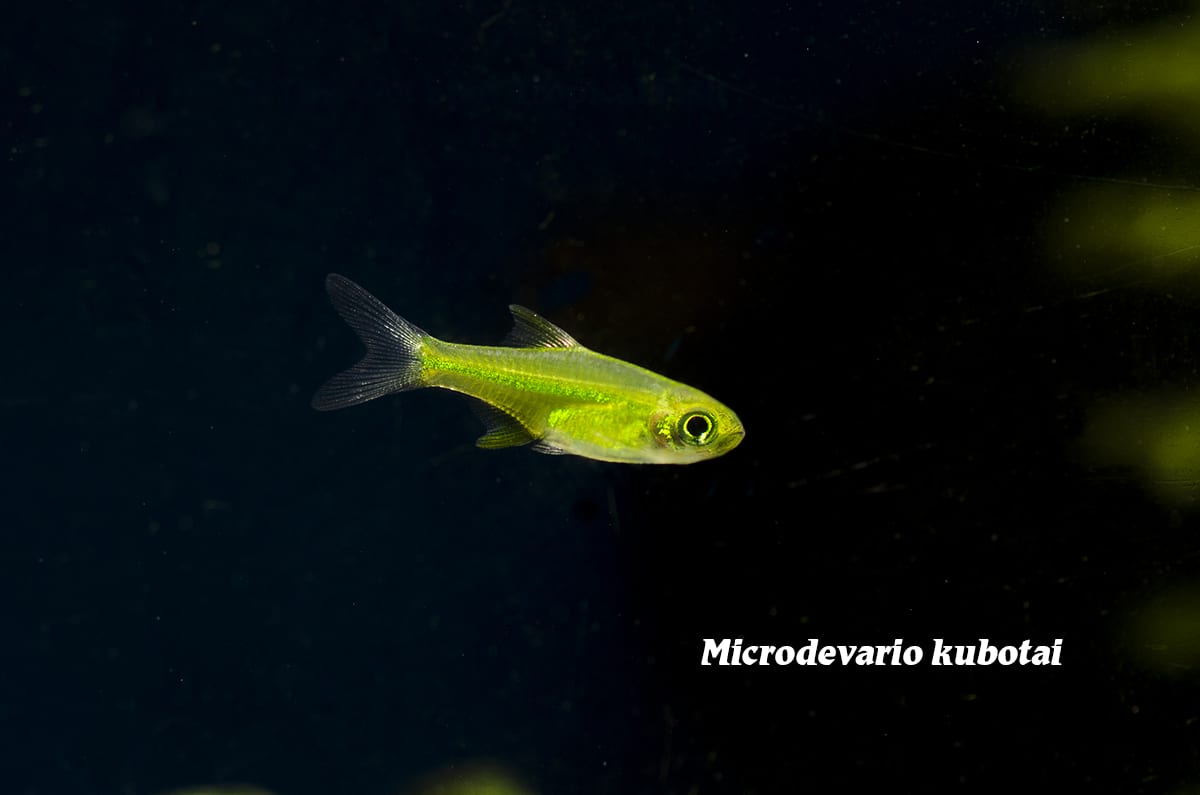Fish me, I’m Irish!
Fish me, I’m Irish!
March 17th marks the death date of a very important figure in Irish culture. One who brought Christianity to their north Atlantic island and went on to become a man of legend, hailed as the Patron Saint of Ireland. Irish or not, most of us know this day as one to wear green (or get pinched), and to imbibe our favorite Irish brews. Rather than drinking like fish, today we honor Patrick by highlighting our favorite shamrock-colored swimmers, though those 2 activities are not necessarily mutually exclusive. Green fish across the world unite! Crowded into our Cathedral-like glass tank halls, we have: Etroplus suratensis, Symphysodon aequifasciatus, and Microdevario kubotai.
Scientific NameEtroplus suratensis
Common NameGreen Chromide
Temperature / pH72 to 82°F / 7.0 to 8.5 pH
Native LocationSri Lanka/India
Preferred DietSmall invertebrates
A green beacon, E. suratensis, is found in brackish habitats of Sri Lanka and India. These “Green Chromide Cichlids” are large, big-eyed, oval-shaped cichlids with spiny anal-fin rays. Reaching up to 14 inches in length, these chromides are clad in a base of green with dark vertical stripes. Preferring brackish estuaries, green chromides adapted to low oxygen levels, and gained the ability to gulp atmospheric oxygen. Biotope tank setups would include sandy substrate, variably-sized rocks, and driftwood branches. Generalist foragers by nature, they predominantly graze aufwuchs and filamentous algae from solid surfaces. Additionally, they consume detritus from bottom substrate including animal and plant matter, and small invertebrates. In captivity they thrive on diets consisting of small, live and frozen items like bloodworm, mosquito larvae, brine, and high-quality prepared foods. A small component of their diet should include vegetal matter like spirulina or chopped peas. Mostly peaceful by nature, they will only eat the smallest of tank mates, but can be happily maintained side-by-side with groups of ‘dither fish’ like small cyprinids. They should not be kept with large, territorial species. Gregarious by nature, they are best kept in groups of 8 or more juveniles to form proper dominance hierarchies; this minimizes chances that specific individuals will be picked on. Sensitive to organic pollutants, frequent 25% water changes are recommended.
Scientific NameSymphysodon aequifasciatus
Common NamePeruvian Green Discus
Temperature / pH82 to 86°F / 5.0 to 7.0 pH
Native LocationAmazon basin
Preferred DietSmall invertebrates
Unknowing Irish patriots of the Amazon, S. aequifasciatus have a lovely wild green color morph. Known as “Peruvian Green Discus”, our wild specimens hail from slow-moving tributaries and forest pools of Peru. Reaching a maximum size of 9 inches, these disc-shaped fish have light green bodies, shamrock fins trimmed and dotted in orange and electric blue, vertical striping, and red eyes. Schooling by nature, large groups of wild discus are found in deep, sheltered areas with tree roots and rocks. They do best in tanks equipped with thin substrate, dense vegetation, lots of cover from furnishings like rocks or caves, and room to grow. Best kept in groups of 5 or more, and can be placed in community tanks including tetras or other ‘dither fish’, and bottom dwellers like corydoras, ancistrus, or loaches. Feeding primarily or zooplankton and invertebrates in nature, they are best fed small, live and frozen foods like bloodworm or brine, and can be trained to accept dried flakes and pellets. Prone to overeating, discus may become bloated.
Scientific NameMicrodevario kubotai
Common NameGreen Rasbora
Temperature / pH70 to 80°F / 6.0 to 7.0 pH
Native LocationThailand
Preferred DietSmall invertebrates
Raised in our facility, and hailing from peninsular Thailand, M. kubotai makes a most impressive St. Patrick’s Day display. These “Green Rasboras” reach 0.75 inches in length, and have translucent bodies with a bright green stripe that shimmers as they swim in large, conspecific groups. Preferring moderately-flowing stretches of minor tributaries with high oxygenation, they do best in tanks with sandy or gravel substrate, rocks, patches of leaf litter, submerged roots or driftwood branches, and lots of aquatic vegetation. Setups designed to resemble flowing rivers are best, and since they are sensitive to water quality they require frequent water changes. Very peaceful by nature, they tend to be skittish and best kept in species-only tanks in groups of at least 10 individuals, though they can be kept alongside similar species found in similar habitats like rasboras or loaches. Likely predating on invertebrates in nature alongside algae and zooplankton, they gladly eat small, dried foods supplemented regularly with live and frozen offerings.
Do your St. Patty’s day plans involve fish? In our objective opinion, they should!…don’t get caught with tanks sans green, or you might get pinched!


